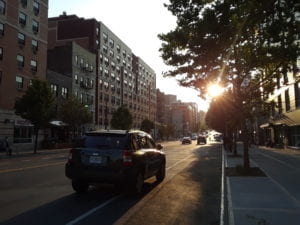On Friday, July 13th, I assisted WHEDco in organizing the Bronx Music at Melrose Festival. The annual festival is meant to celebrate the Bronx’s music heritage with the residents as well as introduce WHEDco and its diverse services to the community. To me, however, the festival was an opportunity to gain new insights regarding my research for advocacy and public space. The BM@M festival offered a glimpse of how public spaces can be used under different governing institutions, regulations and activities.

The event took place at E 161st street, between Melrose and Elton Avenues, where the street was nestled between two mixed-use blocks: Block A on the Southern side and Block B on the Northern side. Block A had continuous commercial spaces at the ground level such as open sidewalk cafés and transparent storefronts, while Block B had two non-residential spaces solid metal doors. Although both sides were identical in terms of design, the vibrancy of Block A made this side of the street more welcoming and had a larger share of pedestrian flow.
As we started laying out the festival’s booths and tents, I started to think about the difference in how pedestrians perceived both sides of the street and this raised an important question: To what extent can street interventions affect the individual boundaries of a person’s comfort zone in a public space? So, I started thinking of the festival as a way to experiment different spatial organizations of the street.
During the festival, the street’s function changed from being a pathway for cars into a pedestrian friendly public space. Police were present at both ends of the street, which increases safety.

After the festival, and before the police remove the barricades, children started using the street as a playground and the two sidewalks became connected by this new intermediate space. In that brief moment, the street was in a state that was neither formal nor informal, but was absolutely owned by the community.

I wonder whether you feel you’ve answered this question: “To what extent can street interventions affect the individual boundaries of a person’s comfort zone in a public space?” By “street interventions” I think you are specifically referring to a street festival, which does reorganize space (as you’ve demonstrated graphically) such that one uses spaces that are predetermined for use one way for most of time into an entirely new way for a brief time. But does one’s individual boundaries change so much as their relationship to regulated space does? And is the goal to change or affect individual boundaries or is it to reconfigure space so that an imposed order is temporarily paused? I think it’s the latter. What’s interesting to me is that the moments between the street’s normal use (i.e. traditional street traffic and sidewalk traffic) and the music festival are when the space feels *truly public.* So I guess I might ask: how can we support community use of space, while still keeping that space safe, legible, and (for lack of a better term) orderly?